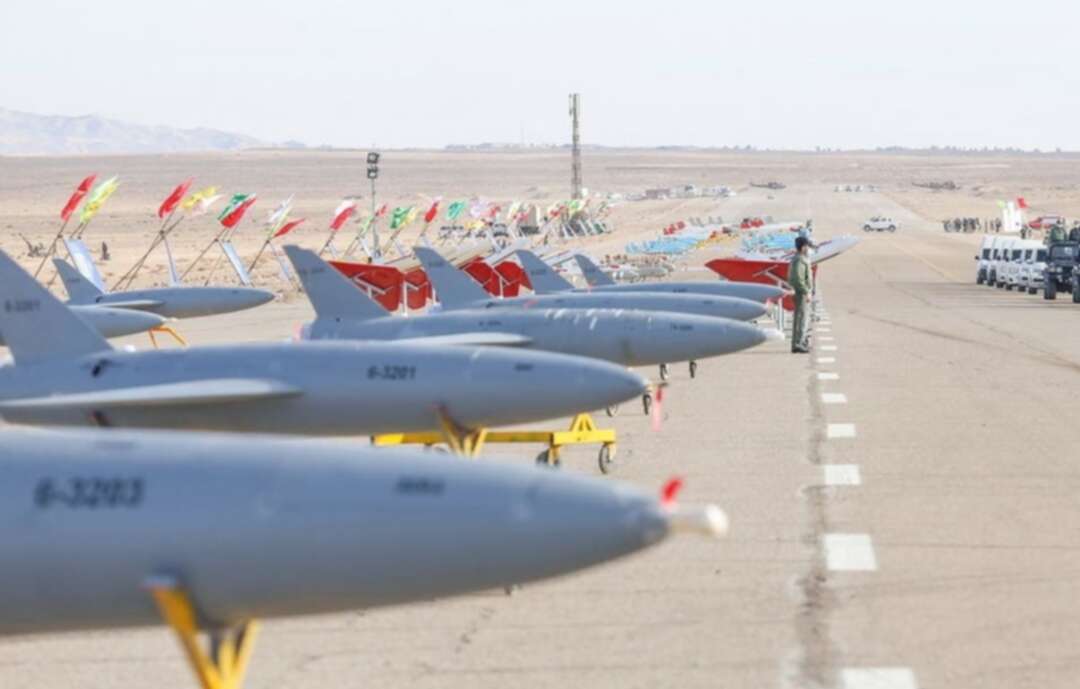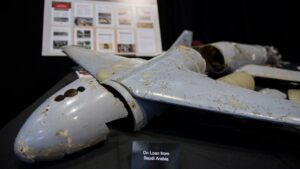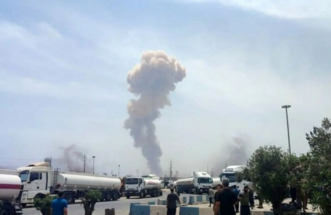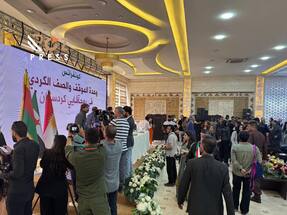-
Saudi drone attacks highlight a new era of ‘war-by-remote’ in the Middle East: Expert

A recent barrage of drone attacks targeting Saudi Arabia highlights a growing era of “war by remote” in the Middle East as terrorists utilize unmanned aerial vehicles (UAVs) to commit acts of violence across the region, experts say.
Yemen’s Iran-backed Houthi militia regularly launches unmanned missiles into Saudi Arabia, many of which Riyadh says it intercepts, and in recent weeks more than a dozen attacks using drones have been reported across the Kingdom. The attacks have drawn worldwide condemnation.
Yossi Mekelberg, a former professor of international relations at Regent’s University London, and a fellow at Chatham House, has been following warfare in the Middle East for decades.
He told Al Arabiya English the Middle East is “seeing more and more unmanned vehicles” being deployed by terrorists in the region.
“If you think about it, it is a cheap way to construct warfare if you have the technology,” he said.
They also have another huge advantage; deniability.
“It is effective, terrorists do not have to risk their own military personnel and it provides the ability for plausible deniability for those behind the attacks,” said Mekelberg.
Drones are not as “obvious” as tanks or traditional air force, meaning terrorists can hide behind a cloak of anonymity until they – if they choose – take credit for such attacks, according to Mekelberg.
“It is a time of war by remote – drones, unfortunately, is the way forward (for terrorists),” he added. “We will see home incidents of it across the region, be in Saudi, be it Syria, Israel, Lebanon, in Afghanistan.”
On Monday night, the Arab Coalition announced it had intercepted and destroyed a ballistic missile fired by the Houthi militia targeting Khamis Mushait. Another explosive drone was also intercepted and destroyed.
 The Coalition: An explosive Houthi drone interception was launched towards Khamis Mushait
The Coalition: An explosive Houthi drone interception was launched towards Khamis MushaitThe attacks on Monday came one day after the Arab Coalition confirmed that Iran supplied the weapons that were used in the attack on Aramco’s oil port and facilities in Saudi Arabia.
Some attacks have previously hit Abha International Airport which is about 120 kilometers (75 miles) from the border with Yemen.
Last week the Arab Coalition intercepted two explosive-laden drones launched by Yemen’s Houthis towards Saudi Arabia’s Jazan and Khamis Mushait, raising the number of such drone attacks to eight over a 24-hour period; attacks which left at least seven civilians injured, according the Saudi authorities.
In February, the Houthis claimed an attack on the Abha airport which caused a civilian plane to catch fire. The militia said the airport was a military target, according to AFP.
The Houthi’s explosive-laden unmanned aerial vehicles (UAV) were the latest in a series of escalated cross-border aerial attacks on the Kingdom by the Iran-backed militia in Yemen.
Mekelberg said while drones were traditionally viewed of as “something small and innocent” this is no longer the case.
“They are definitely not small anymore and they are definitely not innocent.”
Mekelberg said drones or UAVs are now known as a “loitering munition,” autonomous and unmanned technology that can loiter around a target before striking. UAV refers to all types of small and mid-sized autonomous devices with no pilot in them. They can be controlled remotely by a ground-based pilot or can fly following a pre-defined flight plan.
 Another drone sent by Houthis to target Saudi Arabia (File photo)
Another drone sent by Houthis to target Saudi Arabia (File photo)Some drone models, using the latest technology, can use GPS signals from satellites to connect as well as communicate their location to the pilot. Terrorists can use such drone technology for surveillance, reconnaissance or for crashing into targets.
Drones, depending on their type, can travel between tens and hundreds of thousands of miles.
Technology in warfare
“It is the closest thing to artificial intelligence (AI) in warfare – and it is scary,” said Mekelberg, adding that the threat has been growing for years.
“These drones are commanded and guided by human beings – pilots in essence – but those who sit outside than inside a vehicle.”
“Just imagine, in a hypothetical situation, that Iran is targeting a country. It can use a drone without risking one of their own human lives.”
Not risking their own army, can mean terror groups ramp up such attacks, said Mekelberg.
“If you are only risking equipment – not human lives - it can push (terrorists) to escalate the frequency of attacks as losing equipment does not have the same impact as losing one of their own.”
Mekelberg pointed out that it only takes one drone attack to cause significant impact.
In 2019, Saudi Arabia shut down half its oil production after a series of drone strikes hit Saudi Aramco - the world’s largest oil processing facility - in an attack claimed by Yemen’s Houthi rebels.
“This is a clear example of how heavy the price of drone attacks can be,” he said.
To combat the threat, many countries in the region are now investing heavily in drone technology.
Every piece of drone technology sends some sort of signal and can be intercepted if the right technology is there, said Mekelberg. Once detected, drones can be destroyed instantaneously.
“More emphasis now on developing drones and developing technology to protect borders,” he said, adding: “At the end of the day, electronic warfare is all about who is one step ahead.”
source: Jennifer Bell
Image source: Reuters
Levant
You May Also Like
Popular Posts
Caricature
BENEFIT Sponsors BuildHer...
- April 23, 2025
BENEFIT, the Kingdom’s innovator and leading company in Fintech and electronic financial transactions service, has sponsored the BuildHer CityHack 2025 Hackathon, a two-day event spearheaded by the College of Engineering and Technology at the Royal University for Women (RUW).
Aimed at secondary school students, the event brought together a distinguished group of academic professionals and technology experts to mentor and inspire young participants.
More than 100 high school students from across the Kingdom of Bahrain took part in the hackathon, which featured an intensive programme of training workshops and hands-on sessions. These activities were tailored to enhance participants’ critical thinking, collaborative problem-solving, and team-building capabilities, while also encouraging the development of practical and sustainable solutions to contemporary challenges using modern technological tools.
BENEFIT’s Chief Executive Mr. Abdulwahed AlJanahi, commented: “Our support for this educational hackathon reflects our long-term strategic vision to nurture the talents of emerging national youth and empower the next generation of accomplished female leaders in technology. By fostering creativity and innovation, we aim to contribute meaningfully to Bahrain’s comprehensive development goals and align with the aspirations outlined in the Kingdom’s Vision 2030—an ambition in which BENEFIT plays a central role.”
Professor Riyadh Yousif Hamzah, President of the Royal University for Women, commented: “This initiative reflects our commitment to advancing women in STEM fields. We're cultivating a generation of creative, solution-driven female leaders who will drive national development. Our partnership with BENEFIT exemplifies the powerful synergy between academia and private sector in supporting educational innovation.”
Hanan Abdulla Hasan, Senior Manager, PR & Communication at BENEFIT, said: “We are honoured to collaborate with RUW in supporting this remarkable technology-focused event. It highlights our commitment to social responsibility, and our ongoing efforts to enhance the digital and innovation capabilities of young Bahraini women and foster their ability to harness technological tools in the service of a smarter, more sustainable future.”
For his part, Dr. Humam ElAgha, Acting Dean of the College of Engineering and Technology at the University, said: “BuildHer CityHack 2025 embodies our hands-on approach to education. By tackling real-world problems through creative thinking and sustainable solutions, we're preparing women to thrive in the knowledge economy – a cornerstone of the University's vision.”
opinion
Report
ads
Newsletter
Subscribe to our mailing list to get the new updates!






















